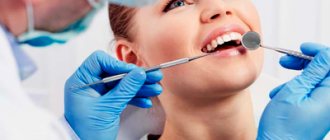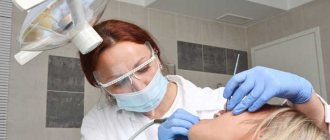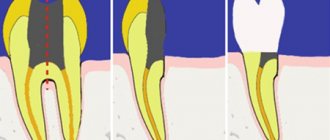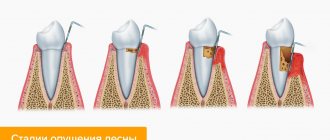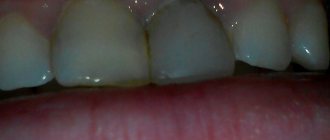From this article you will learn:
- the gums around the wisdom tooth are inflamed: what to do,
- wisdom tooth: hood and its removal (price for 2021),
- how to relieve inflammation.
The article was written by a dental surgeon with more than 19 years of experience.
Difficulty in the eruption of wisdom teeth is often accompanied by the development of inflammation of the gums around them. The mucous membrane of the gums, which partially covers the crown of the erupting wisdom tooth, is called the wisdom tooth hood (Fig. 1-3).
Because The hood over the wisdom tooth is not tightly adjacent to the crown of the tooth - a semi-closed space is formed between them, in which favorable conditions are created for the proliferation of pathogenic bacteria and the development of inflammation. In dentistry, an inflamed hood on a wisdom tooth is usually called “pericoronitis.”
Reasons for the formation of pus in the gums
There are several reasons for the formation of pus:
- The inflammatory process causes a disease such as periodontal disease (gingivitis).
- Periodontal disease.
- Mechanical damage to the gums.
- Chemical or thermal burn.
- Unprofessional removal of tartar, which affected the gums.
- Extensive caries causes pulpitis.
- Failure to comply with hygiene standards when performing dental procedures.
- Unsanitary oral cavity.
- Types 1 and 2 diabetes mellitus.
- Summing up the causes of purulent inflammation of the gums, we can highlight the main factor that causes this disease – the vital activity of pathogenic microorganisms.
What to do if the gums above the wisdom tooth are inflamed?
- Clean thoroughly, even if it bleeds and hurts. After all, as you already know, the cause of inflammation is that plaque and food debris around the “eight” were regularly not cleaned. The plaque microbes did their job - pericoronitis occurred. To more successfully clean plaque around a wisdom tooth, it is better to purchase a brush with elongated front bristles.
Brush with extended front bristles
- Make salt baths (dissolve 1 teaspoon of salt in 1 glass of water at room temperature - never hot!). It is recommended to put the saline solution in your mouth and hold it on the side of the inflamed tooth for several minutes. Such baths are carried out every hour; it is optimal to alternate them with rinsing with chlorhexidine.
- If the swelling does not decrease within a day or two, it is better to consult a dental surgeon. Perhaps an incision (pericoronarotomy) and the prescription of antibacterial and anti-inflammatory drugs are needed. If you have a fever and it hurts to swallow, you can’t hesitate, you need to urgently go to a dental surgeon!
- If inflammation of the gums around the wisdom tooth occurs regularly and you have repeatedly visited the dentist for an incision in the gum area above the wisdom tooth, this is an indication for removing the “eight”. Surgeons recommend removing the tooth as planned, not during an exacerbation or during an active inflammatory process. Such removal will be easier for you, painless and the body will need much less time to recover.
After reading the article, did you remember your torment with the eruption of wisdom teeth? We invite you to a consultation with a dental surgeon at the KANO clinic network. Our specialists will prescribe the necessary diagnostic X-ray and tell you what to do with the problem “eight”.
Signs of pus and purulent inflammation
- severe pain in the area of the wisdom tooth; when you press on the gum, pus is released;
- redness of the gums and swelling;
- a large carious cavity is filled with softened soft tissue;
- colored plaque on the tooth and tartar;
- enlarged lymph nodes;
- change in facial contour. It becomes asymmetrical.
What problems can arise from wisdom teeth?
- Due to the fact that the tooth is located far in the dentition, it is difficult to properly clean it of plaque and food debris. As a result, caries occurs, and then quickly becomes complicated into pulpitis. Anyone who knows pulp pain will not confuse it with anything.
- Wisdom teeth often do not have enough space in the jaw, causing them to grow sideways or even towards the second molar (seven), permanently damaging it.
- Another complication is the formation of a cyst in the area of the erupting wisdom tooth. This cyst grows quite rapidly, which leads to rapid destruction of bone tissue. Its presence on an x-ray is an absolute indication for wisdom tooth removal.
- In the absence of space for eruption, the “figure eight” crowds and shifts adjacent teeth, causing them to become crowded and crooked in position. For this reason, the eruption of wisdom teeth can lead to treatment with braces or aligners even for a person with previously completely straight teeth.
- If the wisdom tooth has not fully erupted, but is partially hidden under the gingival (mucous) hood, pericoronitis (pericoronitis) occurs. This is the name for inflammation of the gums around an under-erupted wisdom tooth.
Treatment
Treatment is prescribed after a visual examination of the oral cavity and determination of the source of pus. Treatment of purulent inflammation can be:
- In a therapeutic way with the help of medicinal drugs.
- Physiotherapeutic.
- Surgery.
If purulent discharge does not stop after a course of therapeutic treatment, the doctor will prescribe surgery. Before the operation, plaque and tartar are cleaned and the mouth is disinfected.
An injection with a local anesthetic is injected into the gum and the gum is cut. The gum mucosa is cleaned of pus. If the fistula through which pus flowed is large, then a drainage is inserted. In the postoperative period, the patient is prescribed therapeutic treatment, which includes taking antibiotics and rinsing the mouth with a 0.05% chlorhexide solution, and is prescribed a complex of vitamins and minerals.
Every day, until complete healing, the patient must come to the dentist, where he is given an antibacterial application on the gum of the wisdom tooth. The patient must strictly follow all the dentist’s recommendations for oral care and consume only liquid foods.
Features of tooth extraction in the upper jaw
The structure of the upper and lower jaws is significantly different. They also vary in density and location. Therefore, the method of tooth extraction will differ:
- on the upper jaw the operation is faster;
- the recovery period is shorter;
- pain relief is simpler and more effective.
Complications during tooth extraction in the upper jaw occur less frequently than in the lower jaw.
Anesthesia
The secret of high-quality pain relief is the correct delivery of the drug to the nerve. The choice of anesthesia method takes into account the patient’s age, his general condition, and the complexity of the tooth being removed.
Anesthesia of the upper jaw
The upper jaw is less dense than the lower jaw. It is covered with a cortical plate with many holes. Nerves and blood vessels pass through them. Pain relief is easier and faster than in the lower jaw
Sinus damage
Above the upper jaw is the nasal sinus, also known as the maxillary sinus. Its bottom may be close to the root of the tooth being removed. Then, during removal, sinus perforation may occur. This complication is typical for surgery on molars. This pattern is explained by the fact that the jaw in the area of the incisors is longer, and the nasal cavity is further away relative to them.
The main sign of sinus perforation is the escape of air, food and fluid through the nose. There is foam in the hole. Hospitalization in a hospital may be indicated for treatment.
Entry of part of the root into the sinus
Due to perforation of the sinus, part of the root can get inside it. This is caused by thinning of the bone plate or errors during the removal operation.
The symptoms when part of the root gets into the sinus are the same as when perforation occurs: air and contents of the oral cavity escape through the nose. But at the same time there is pain and increased body temperature. Treatment requires hospitalization.
Why do children's teeth rot?
In children, the composition of saliva is not the same as in adults. Its antibacterial properties are low; in a warm, humid environment, microbes multiply quickly. The disease is not only common, it progresses rapidly. Caries spreads in width and depth. Single events are rare; usually several teeth are affected at once. For children, timely identification and treatment of problem teeth is of particular importance. Rotten teeth can cause:
- pulpitis and periodontitis;
- malocclusion;
- loss of milk and permanent teeth;
- inflammation of the maxillofacial apparatus.
Bad teeth affect the social adaptation of children and lead to psychological problems.
Prevention includes hygiene procedures, limiting sweets, a balanced diet and regular dental examinations.
How to prevent pain
To reduce the risk of inflammatory processes in the socket and the development of pain, the doctor gives the patient recommendations on how to behave immediately after extraction:
- hold a sterile swab between the teeth, which is placed to stop gum bleeding for at least 20 minutes;
- refrain from eating for 2–3 hours after removal;
- take a painkiller tablet in the first 1–2 hours after the wisdom tooth root has been removed, Ketorol, Ketanov, Baralgin are suitable;
- avoid smoking, alcoholic beverages, spicy foods, hot and cold drinks, physical activity on the first day;
- rinse with antiseptic solutions Furacilin, Chlorhexidine, chamomile decoction, starting from the second day after extraction (this cannot be done earlier, so that a blood clot will form in the hole, it will protect the wound from infection);
- apply antiseptic ointments and gels to the affected area - Metrogyl Denta, Asepta, Cholisal, Solcoseryl.
Antibacterial drugs are usually prescribed in cases where a tooth has been pulled out, surrounded by suppuration or with flux located nearby. Then the patient is required to take the drugs for at least 5–7 days in a row, in order to avoid recurrent complications
As you can see, modern dentistry has stepped far forward, giving patients the opportunity to remove problem teeth painlessly and with the least risk of complications. The drugs used today for anesthesia do not cause side effects or allergies, have a quick and long-lasting effect, allowing you to reduce discomfort to a minimum. After extraction, you do not need to go to the dentist to remove the sutures again - doctors use self-absorbing threads, as they save the tissue from additional trauma.
An important point is the psychological mood of the patient himself. Having read and heard stories about terrible pain during tooth extraction, a person delays a visit to the doctor, provoking complications that can be avoided by seeking help in a timely manner. Therefore, you should not be afraid of the dental chair - the doctor will do everything possible to ensure that the patient does not experience discomfort, and the fear of dentists is a thing of the past.
Implantation is a solution for advanced cases
Alas, if the root of a tooth has rotted, then the only solution is removal. But even here, dentists offer a method that will help restore a rotten tooth - implantation. The implant will stop bone loss, prevent loosening and tilting of neighboring teeth, and restore your smile. The immediate loading method involves placing an implant immediately after tooth extraction. There is no need to wait for the hole to heal and you can chew almost immediately.
Teeth and pregnancy
We found out why children's teeth rot. There is another group of people particularly at risk of tooth decay. These are pregnant women. Some scientists classify pregnancy as an immunodeficiency state - the body's resistance to pathogens decreases to such an extent. It’s no wonder that during pregnancy, general diseases worsen and dental problems begin. The increased content of hormones in the body reduces the barrier ability of the epithelium, microorganisms more easily penetrate the gums and begin to multiply.
Help protect your teeth:
- rational and balanced diet;
- multivitamin complexes;
- professional oral hygiene;
- herbal baths;
- applications with calcium and phosphates.
Causes of tooth decay
Yes, we all know that you need to brush your teeth 2 times a day, be sure to use dental floss and visit the dentist 2 times a year. Many patients follow these recommendations, but their teeth still deteriorate and rot. Poor hygiene is not the only reason why teeth deteriorate. There are other factors:
- Gum diseases
provoke the proliferation of bacteria, which literally gnaw through the enamel and destroy tooth tissue; - genetics
plays a role in the ability of teeth to resist pathogenic factors; - an unfavorable ecological environment
leads to the fact that in industrial areas there are more dental problems than in places where there are no factories; - Water quality
directly affects teeth. Low content of useful minerals (fluorine, calcium), high content of heavy metal salts can destroy teeth, despite hygiene; - bad habits
. Smokers have worse teeth than non-smokers and treatment is more difficult; - general diseases
, for example, problems with the gastrointestinal tract, negatively affect the condition of the teeth; - carbohydrates
in the diet , as well as hard food products that injure the gums and enamel lead to tooth decay.
To understand why teeth rot, you need to undergo an examination. Don’t be surprised if the doctor asks you to take tests or do an ultrasound. Dental treatment requires a comprehensive approach and diagnosis is more important than ever. Having found out why teeth are rotting, the doctor will prescribe adequate treatment.
Removal methods without pain
To ensure that the removal of problematic eighth molars is painless, dentists have a number of anesthetic drugs that are selected depending on the clinical situation. Previously, extraction was carried out using the drug Novocain, which was a good pain reliever and was considered a low-toxic substance. However, during the tests, a large number of various complications after its use were confirmed, from allergic reactions to anaphylactic shock.
Anesthesia for wisdom tooth removal
Today, there are much more effective and safe drugs that allow extraction to be carried out quickly and painlessly. Lidocaine is also a common drug - it is used in most budget dentistries; the drug shows good results in pain relief, which are several times higher than those of Novocaine.
There is rarely an allergic reaction to the product, however, during prolonged manipulations, doctors have to administer a large dose of the substance from 3 to 10 ml. To administer Lidocaine, plastic syringes with not very sharp needles are used, which is why the patient feels severe pain after the operation. This explains the fact why it is painful to swallow after extraction, and the discomfort intensely radiates to the ear and throat.
To avoid pain and discomfort for the patient during removal, dentists give preference to articaine drugs, such as Ultracaine, Septanest, Ubistezin
They are administered using carpule metal syringes, the ampoule does not need to be opened, contact with air is excluded, and the dose of adrenaline intended to extend the freezing period is precise. This reduces to zero the risk of complications such as rapid heartbeat, dizziness and panic. For weakened patients, disabled people, pregnant women and adolescents, Scandonest injections are more suitable - this drug does not cause vasodilation and does not contain adrenaline.
Stages
Caries, like a secret agent, begins to act on the sly and may not make itself felt for years. Its initial stage is called the “white spot stage.” Well, how can you see white on white? That is why it is important to visit the dentist regularly - the specialist will highlight the white spot against the background of the enamel and cure caries in time. And if you start it, the disease goes to the next level:
- Surface.
The enamel is still intact, but in the area of the stain it becomes rough. The stain deepens. The tooth begins to react to cold and hot. - Average.
Caries penetrates to the dentin, but it does not provide access to the pulp. A damaged tooth reacts to temperature, mechanical, and chemical stimuli. But the pain is not constant, it goes away quickly. - Deep.
The pain is sharp when touched, but gradually subsides. A carious cavity is visible to the naked eye.
